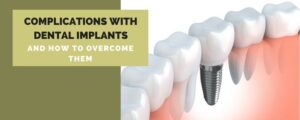
Dental implants are by far the best method of replacing teeth in the long term when one considers benefits, function and long term success. Studies show that traditional crowns and bridges have a 15-20% failure rate within ten years, yet implants have less than 2% failure rate after ten years. If one were to collect longer term data, say 15 to 20 years, the disparity would be even greater.
-
Infection and Poor Healing – Provided the dentist follows aseptic/sterile surgical techniques and precautions the chance of infection is extremely low, even when we consider we are working within the mouth which is full of bacteria. Patients are generally covered with antibiotics as an added precaution.
-
Medical Condition Affecting Healing – Generally speaking, if you have lost teeth, you are a potential candidate for dental implant surgery. However, there are certain conditions and diseases that can affect whether dental implants are right for you – this is where the importance of a proper medical assessment comes in. Conditions such as cancer, radiation to the jaws, alcoholism, uncontrolled gum disease or diabetes, smoking, certain medications and various other ailments can affect your bodies ability to heal and whether dental implants will fuse to your bone. These are not necessarily absolute contraindications, but steps may need to be taken to ensure that you will heal properly.
-
Surgical Technique – A skilled dental surgeon will know the osseo-integration process and be skilled in proper surgical techniques. In those cases healing is often very comfortable and uneventful. If not, the site is more prone to swelling, pain, infection and possible failure of the implant. This becomes more critical if the area is slightly deficient in bone volume or is very dense.
-
Micromovement of the Dental Implant – Dental implants must remain immobile for a healing period to allow osseo-integration to occur. The analogy I give my patients is similar to when we break a bone in our arm or leg. The fracture is immobilized by use of a cast because if there is movement the bony fracture will not heal. Implants are very similar.
-
Lack of Bone – For an implant to be successful, it ideally needs to have bone grow around it on all sides. If the bone is deficient in height or width, steps need to be taken to ensure that bone will indeed grow against the implant.
-
Not Following Doctor’s Instructions – The post-op instructions are usually fairly straight forward and simple. Keep heavy physical activity to a minimum (usually for a few days), keep the surgical site clean, avoid eating certain foods if instructed to do so, and take your medications as recommended. There may be other specific recommendations that are given to you depending on the surgery being performed or your particular circumstances.
-
Failure to keep the area clean and maintained – It’s very important you maintain these new teeth and implants. Although I mentioned in previous blogs that implants are not prone to the same problems we see with natural teeth such as fracture decay and in infections they do require maintenance. If you have dental implants, you have made a major investment in your dental health. It needs to be maintained with simple brushing, flossing and a regular checkup with your general dentist and/or implant dentist. If you get excessive food or bacterial plaque around an implant and do not clean it regularly it will cause inflammation in the gums which can lead to bone loss, infection and problems and/or even loss of the implant.
-
Too much stress and forces on the implants – Once an implant has integrated with the bone it is extremely solid…it feels much like a “nail in concrete”. Unfortunately bone is not concrete. If there is excessive lateral stress on a dental implant physiologically the bone will be lost. This may create a periodontal (gum) pocket which in turn will then allow unhealthy bacteria to grow and colonize….this sets up a cascade of event whereby more bone can be lost, infection set in and the implant can eventually be lost.
-
Less than ideal placement or treatment planning – In some cases patients have had dental implants placed very successfully and have healed very well, only to find that when the teeth are to be made the implants cannot be used. In some cases it is because the implants are not in the right location or angle or the esthetics of the situation will not allow the implant to be useful. The dental surgeon who is placing your dental implants should know exactly what type of teeth you will eventually have because that will determine exactly where, how many and at what angle the implants need to be placed. Therefore your implant treatment needs to start not with a surgeon, but with the denturist who will be providing in the final teeth.

